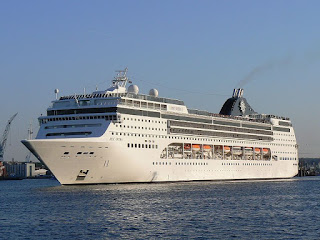Billionaire started with one cargo vessel
 |
| Gianluigi Aponti launched his MSC company in 1970 with one ship |
He and his wife, Rafaela, a partner in the business, have an estimated net worth of $11.1 billion, according to Forbes magazine.
The Mediterranean Shipping Company has more than 510 container ships, making it the second largest such business in the world. Only the Danish company Maersk is bigger.
MSC Cruises, meanwhile, has grown into the fourth largest cruise company in the world and the largest in entirely private ownership. With offices in 45 countries, it employs 23,500 people, with a fleet of 17 luxury cruise liners.
Overall, the Mediterranean Shipping Company, which Aponte began in 1970 with one cargo vessel, has more than 60,000 staff in 150 countries.
Aponte has been able to trace his seafaring ancestry back to the 17th century. His family’s roots are on the Sorrentine Peninsula and there are records of his family’s boats ferrying goods between Naples and Castellammare di Stabia, just along the coast.
His own involvement after the death of his father, who had left Italy to open a hotel in Somalia. Gianlugi returned to his homeland and enrolled at the nautical institute in Naples. He joined the company of the Naples shipping entrepreneur, Achille Lauro, and was employed on the Naples-to-Capri ferry fleet. Eventually, he became a captain.
 |
| The MSC logo can be seen on all of the company's cruise ships |
Aponte for a while worked in banking but craved a return to the maritime industry. He raised $280,000 to buy Patricia, a German freighter, and in 1970 established the Mediterranean Shipping Company. Another cargo ship, which he named Rafaela after his wife, followed a year later.
Operating largely between Europe and Africa, Aponte's fleet had expanded to 20 cargo ships by the 1980s, which the billionaire sold to move into container shipping.
He diversified into cruise lines after buying his mentor Achille Lauro's cruise fleet in 1987, initially under the name Starlauro. The company was renamed MSC Cruises in 1995.
Among the company’s first ships was the ill-fated passenger ship named Achille Lauro, which in 1985 was hijacked by members of the Palestine Liberation Front off the coast of Egypt and in 1994 caught fire and sank off Somalia in the Indian Ocean.
 |
| The MSC Opera, one of the Lirica class vessels that marked the start of the company's investment in modern ships |
This began with the purchase or commission of four Lirica class vessels, each with the capacity to carry more than 2,000 passengers. Each subsequent generation of cruise ships bearing the company’s distinctive star logo has been bigger than the previous one.
The latest is the Meraviglia class, which comprises two enormous boats, each with 15 passenger decks and which can carry 4,500 guests in addition to more than 1,500 crew. The Meraviglia is the fourth largest cruise ship in service anywhere in the world.
Another massive investment programme was launched in 2014, which included refurbishment of the original Lirica vessels in addition to plans for new boats. Between 2014 and 2026, this investment is expected to total $11.6 million, with an even bigger Meraviglia on the horizon, with capacity for 6,334 guests and powered by Liquefied Natural Gas.
MSC Cruises already has the honour of being the first cruise company in the world to be awarded the coveted ‘6 Golden Pearls’ for its outstanding standards in environmental protection, health and safety.
Aponte has been decorated with many awards, including in 2009 a prize for "Neapolitan Excellence in the World". Alongside the footballer Fabio Cannavaro, who captained the Italy team that won the World Cup in 2006, and the ballerina Ambra Vallo, he was presented with the award at a ceremony at the Teatro di San Carlo in Naples by the then Italian prime minister Silvio Berlusconi.
Something of a recluse, Aponte makes few public appearances, largely limited to the christenings of new MSC cruise ships. He lives with his wife in Geneva. His children, Diego and Alexa, both work at MSC, as chief executive and chief financial officer respectively.
 |
| A clifftop hotel in Sant'Agnello with Vesuvius in the background, across of the Gulf of Naples |
Aponte’s birthplace of Sant’Agnello is a small town of just over 9,000 inhabitants which neighbours Sorrento and Piano di Sorrento, which along with another small town, Meta di Sorrento, enjoy a clifftop location overlooking the Gulf of Sorrento, a picturesque bay that forms part of the larger Gulf of Naples. Like the bigger and better-known Sorrento, Sant’Agnello’s economy relies heavily on the tourist industry and has plenty of hotels and restaurants.
| The medieval castle from which the resort of Castellammare di Stabia, built above a buried Roman city, takes its name |
Castellammare di Stabia, a one-time thriving resort now more often associated with shipyards, was built over the ruins of the ancient Stabiae, a Roman village destroyed in 79 AD by the violent eruption of the Vesuvius volcano, which buried Pompeii and Herculaneum. Some of the ruins are being excavated. The name of the town is said to derive from the medieval castle that overlooks the Gulf of Naples, which can be found alongside the road from Castellammare to Sorrento, Castello a Mare meaning Castle on the Sea. The town was the birthplace of Pliny the Elder, who was a philosopher and author as well as a military commander of the early Roman empire.
More reading:
Sophia Loren, Neapolitan siren of the silver screen
Achille Vianelli, the artist who captured the character of Naples
How Cannavaro led Italy to a fourth World Cup
Also on this day:
1574: The death of Giorgio Vasari, painter and architect who was art's first historian
1914: The birth of politician Giorgio Almirante
1980: The plane crash known as the Ustica Massacre
Home




